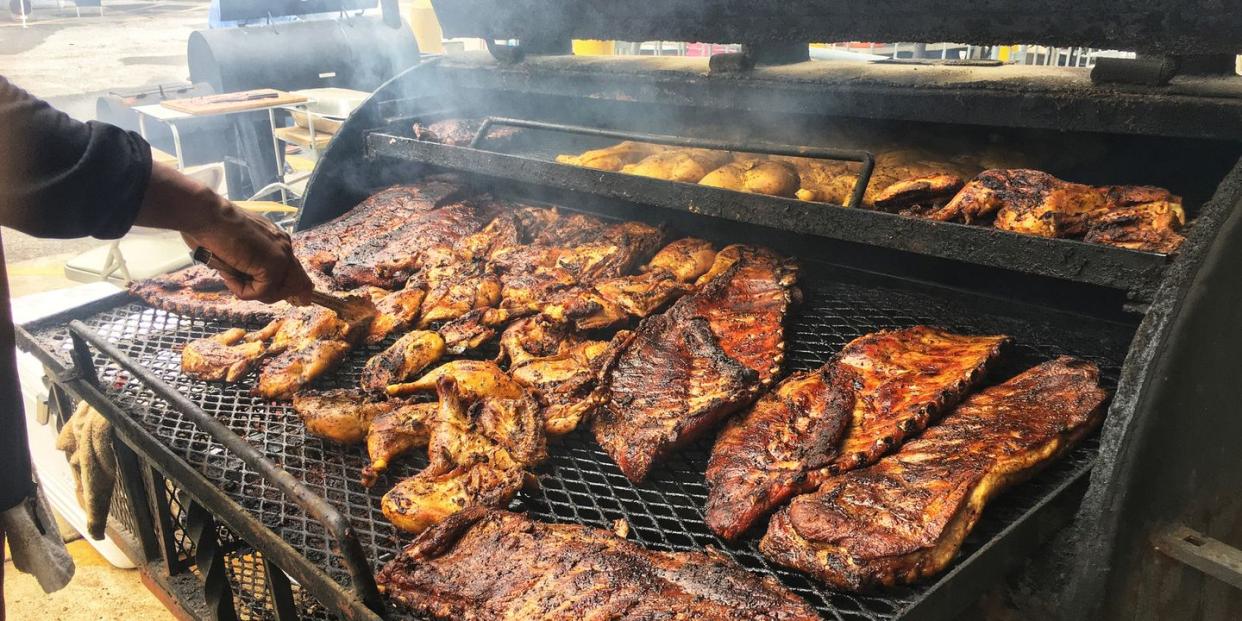Everything You Need To Know About How To Smoke Meat

Smoke is the soul of barbecue. Without it there would be no Kansas City ribs, Texas brisket, or Carolina pork shoulder—not to mention pastrami, bacon, and kippered salmon.
You might think you need a professional barbecue pit to do smoking, but it’s easy to smoke at home using a charcoal grill, like a Weber kettle, or kamado cooker, like a Big Green Egg. If you prefer to invest in a smoker, there are hundreds to choose from (see our picks here): water smokers, like the Weber Smoky Mountain; pellet smokers (e.g. Green Mountain); gas-fired smokers (e.g. Masterbuilt); electric smokers (e.g. Bradley), and more. Sorry, folks: It’s difficult to achieve authentic smoke flavor on a gas grill.
We know it when we see, smell, and taste it. But why does it make food taste so damnably delicious? Simply defined, smoke is a vaporous byproduct that results when you burn wood or other organic material like hay (used in Italy) or tea and rice (used in China). Smoke contains literally hundreds of compounds, from carbonyls—responsible for the handsome brown color of smoked foods—to phenols, such as creosol (which produces a whiskey-like flavor) and vanillin (which gives smoked foods a vanilla-like sweetness).
Different foods need different temps. Adjust the grill vents to obtain the proper temperature: more air raises the heat, less air lowers it. (Another way to reduce the temperature is to use less charcoal.) Good airflow is essential—your smoke should be a wispy pale blue (black or white smoke indicate too much wood or a fire starved for oxygen).
For classic barbecue, such as brisket or spareribs, smoke “low and slow”—at 250 degrees for an extended period: 4 to 5 hours for pork ribs; 5 to 7 hours for pork shoulder; 8 to 12 hours or more for brisket.
To smoke chicken and salmon or trout, work at a higher temperature (350 to 400 degrees): 1 to 1 1/2 hours for the former; 20 to 30 minutes for the latter.

Set it up for indirect grilling, with the embers mounded at opposite sides of the grill and a foil drip pan in the center. If using wood chips (head here for our guide), soak in water for 30 minutes to slow the rate of combustion, then drain, and add them to the coals. (You’ll need about 1 1/2 cups.) If using hardwood chunks, add 1 large or 2 small chunks to the coals—no need to soak them. Replenish the wood every 45 minutes or so, and charcoal as needed—your goal is to keep a light but steady stream of smoke flowing.
Season the raw meat with salt and pepper or your favorite barbecue rub (mine consists of equal parts salt, pepper, paprika, and brown sugar). Bacon and pastrami start with a week-long soak in a brine, made by adding 1 cup sea salt and 1 tablespoon sodium nitrite (a curing salt)—plus optional flavorings, such as garlic or sugar—to 1 gallon of water. Drain the meat well, blotting with paper towels, then let it air dry in the refrigerator until tacky (sticky), 2 hours. Smoke adheres best to meats that are moist, but not wet.
When you get the process right, your meat will display a smoke ring: a handsome 1/4-inch pinkish-red band just below the “bark” (the crusty surface of the meat)—the result of the nitrogen dioxide in the smoke, which binds with the myoglobin to turn the periphery of the meat pink.
Many pit masters finish their ribs with barbecue sauce—applied towards the end of cooking so the sugars in the sauce don’t burn. I like to brush ribs with barbecue sauce, then sizzle them directly over a hot fire for 3 to 5 minutes per side right before serving.
Don’t limit your smoking to meats and seafood, because vegetables, cheese, eggs, and even desserts and cocktails are delectable smoked. The next time you make gazpacho, smoke the tomatoes and peppers. Or smoke halved hard-cooked eggs to make amazing deviled eggs or egg salad. Or instead of baking a fruit crisp, crumble, or cobbler, cook them in the smoker. You can even smoke tomato juice in a shallow pan to make a cocktail I call a Smoky Mary.
You Might Also Like

